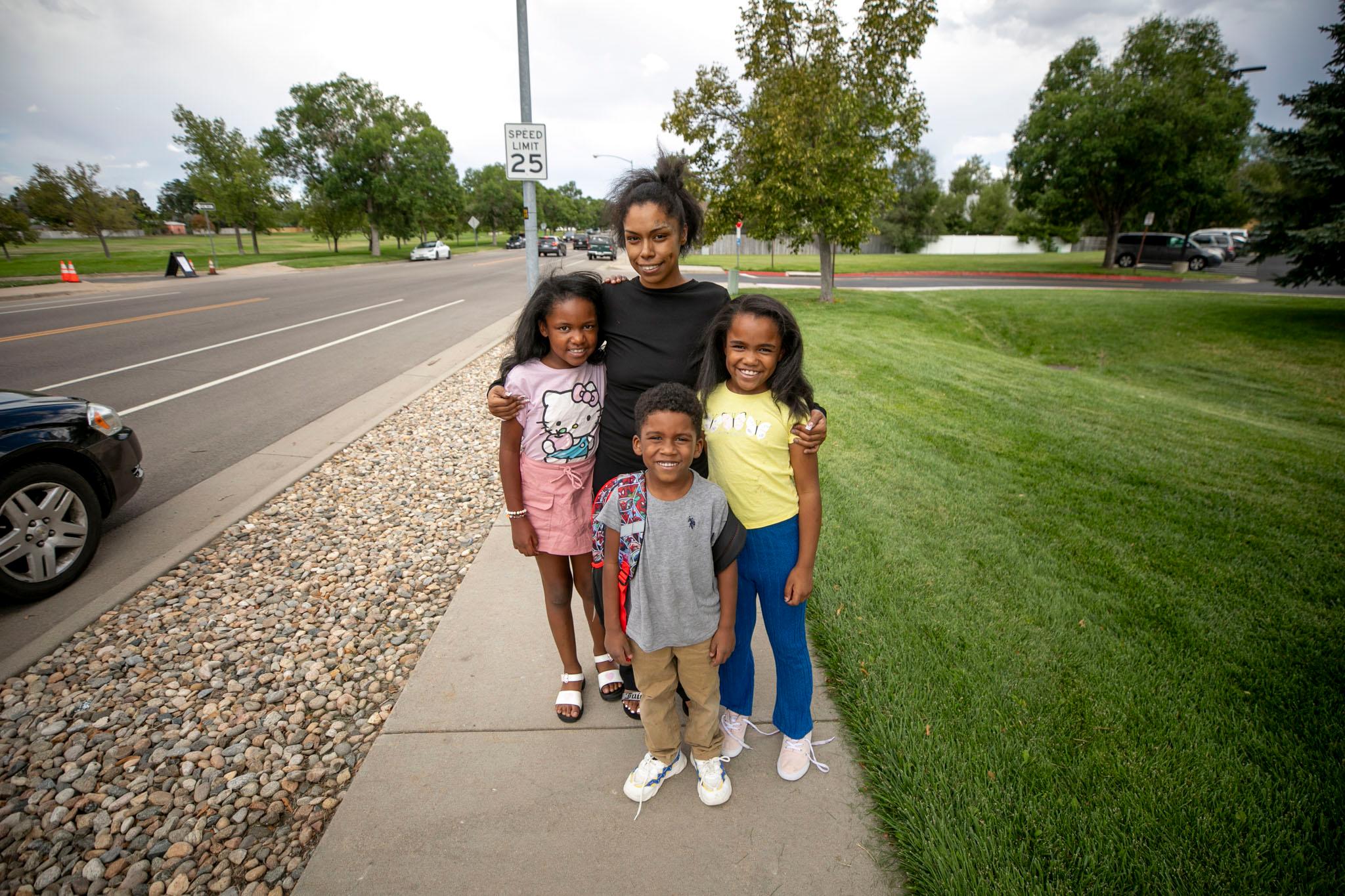
Hunter Ambrose expects a promotion from operations manager to store manager at Dollar Tree. With her raise, she might get some new furniture for the $1500-a-month, two-bedroom apartment where she lives with her kids in a scrappy, noisy complex in Aurora.
Dressed in jeans, her hair in a ponytail and her eyes tired, she was calling an Uber for her pre-teen son while making sure one of her two daughters, running around in a bright yellow oversized nightshirt, felt included during an interview with a reporter.
“Can you say hi? Can you tell Elaine ‘hello’?” she said. She said goodbye to her son as he left to get in the ride-share, while simultaneously listening to her other kids playing in the back bedroom of the sparsely furnished home.
Around this time last year, the 31-year-old mom and her three kids were living out of her Kia, parked on the side of the road, and, when possible, renting a room in an Extended Stay hotel.
What happened in between? Lots of hard work, problem-solving and prayer – and the intervention of the Denver Basic Income Project, a research program at the University of Denver.
The goal of the $9 million study – funded by private philanthropies and the city of Denver – was to find out what would happen if people experiencing homelessness got a lump sum of money, no strings attached. Would it provide an immediate boost to their circumstances and launch them into housing? Or would it be spent in ways that left them no better off, housing-wise, than before?
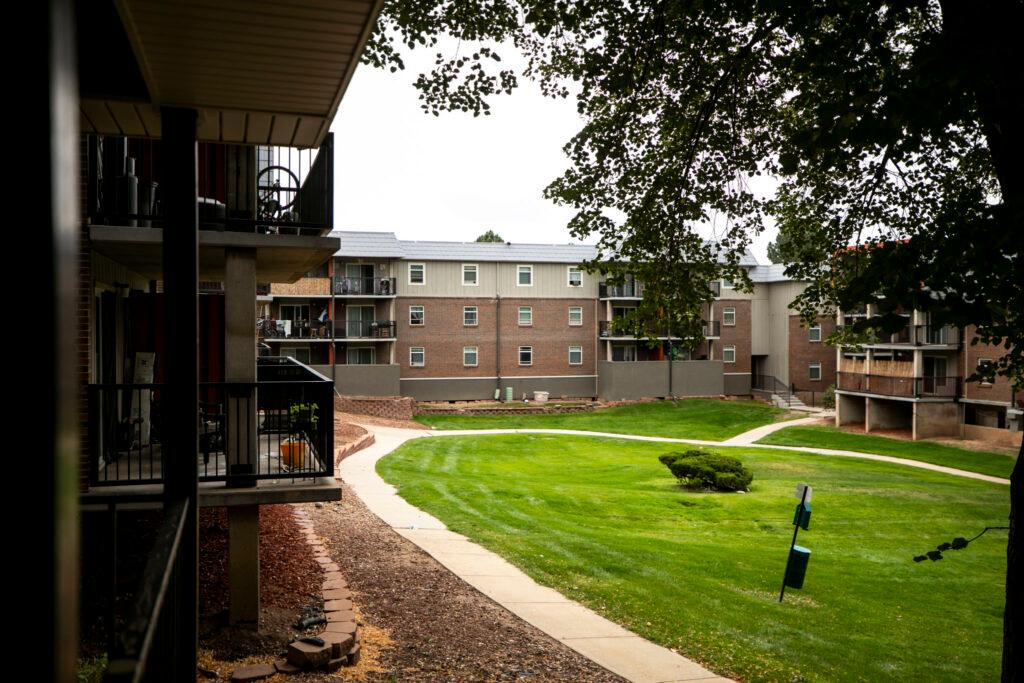
Ambrose was part of the study led by a nine-person research team, which began in October 2022. It included 820 adults experiencing homelessness who were given varying amounts of money with no questions asked about how they’d use it, in December 2022, January 2023, and February 2024. The study has recently been extended and researchers are currently raising funds to continue it for another six months.
The team set up the study with three tiers. One group got $50 a month – that was the control group, of which Ambrose was a part. Another group got $1,000 a month, and the third got a lump sum of over $6,500 at the start of the study and $500 a month thereafter for the first year, $1,000 for the second. Participants also received a cell phone – paid for by the study – so researchers could check in with them more easily.
The results surprised the researchers: the group getting $50 per month did as well as the group getting the most money.
“Probably our most surprising finding was we didn’t see a lot of differences there,” said Daniel Brisson, Professor and Executive Director of the Center for Housing and Homelessness at the University of Denver Graduate School of Social Work. “In fact, our third group, which we call our active control group that received $50 a month, also seemed to do well, particularly in housing…. We expected the other two groups to do better than our comparison group, but in fact, people from all three groups did OK.”
The DU study is one of few in the US and Canada that poses the question of how being given money impacts homelessness. To get participants, researchers went to community-based organizations such as shelters to connect with people who were currently unhoused.
The study found that:
- Regardless of which group participants were in, the opportunity to participate was seen as a blessing;
- The attention and support that came with the interview portion of the study gave participants hope;
- People receiving the highest amount of money reported both a reduction in stress and the ability to do things – such as get an education to train for a better-paying job – that they couldn’t have done without the support.
Some of the study’s limitations and challenges were:
- Being in survival mode, unhoused people prioritize study participation lower than activities of survival (such as finding a space to feel safe or finding food, etc.), making keeping up with them sometimes tricky and lowering overall participation numbers;
- Terms like “stress” and “safety” mean different things based on one’s housing status; and
- The study only included those connected to community-based organizations, people already motivated to seek solutions out of homelessness. (“We wanted to [include those living on the streets not connected to community-based organizations] but it’s very expensive,” Brisson said. “It would be a much more expensive study if we were to be on the ground reaching out to people.”)
CPR News spoke with three of the 820 participants – one from each group – to see how being in the study impacted their housing situation. They were each interviewed in person in their current environments, after being interviewed first by phone.
Hunter Ambrose
Hunter Elizabeth Ambrose, whose journey from having nowhere to go at night beside her car or a motel – to living in a two-bedroom apartment in Aurora – had been going on for most of her life. It began when she was placed in foster care as a toddler in Los Angeles, she said.
Throughout her childhood and adolescence, she bounced from group homes to foster families; at age 11, in one home she was repeatedly sexually assaulted by the spouse of her foster mother, she wrote in her self-published book, Relentless.
From there she started running away, she said. When she aged out of foster care after numerous placements, she did what she had to do to survive, and eventually came to Denver in search of her mother; she lived with her for a short while, she said, but her mother’s alcoholism and toxicity made life unbearable, so she left.
In the years that followed, she said, she was able to accomplish some of her goals: she visited India, took some college courses, and became a notary public. With three kids by two fathers, one of whom she co-parents with, costs of being a single mom overwhelmed the salary she was able to earn, and with no family to help out, she fell into homelessness from time to time.
“There were so many times where I didn’t know what was going to happen next for me. I didn’t know what to expect,” she said. “It was kind of traumatizing.”
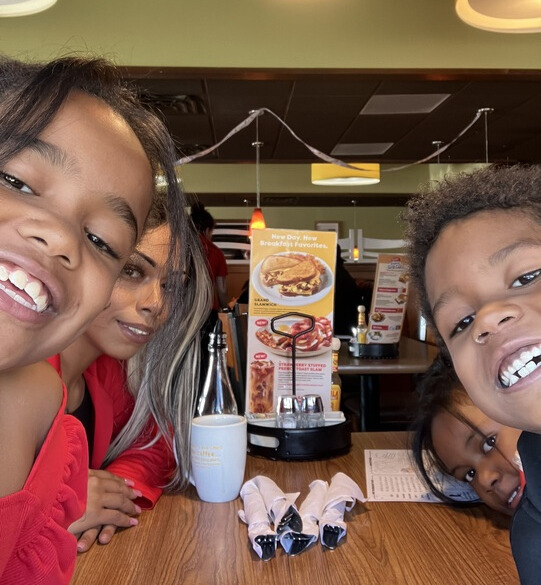
When she became a part of the study, she was in the Salvation Army’s shelter service network; they’d placed her in a hotel in Denver’s Central Park neighborhood with her children – a relief after they’d been living in her car for a period of time. Around November of last year, she learned of the Denver Basic Income Project study through the shelter.
Working as an assistant manager at the discount retail chain Dollar Tree, she’d hoped to get picked for one of the groups that received more money, but when she wasn’t, she was still glad to feel a part of something. Besides getting a $50 payment each month, she said the participation benefited her because when interviewed by the researchers for the qualitative portion of the study, she got attention and concern she wasn’t used to. For her, that was more meaningful than the money.
“It’s not like they completely changed my life, but they have been a part of my life for a few years now – from a place where I was in my homelessness, to seeing me fight through that and get out of the shelter and now in my own place and publishing my book and now becoming an assistant store manager. They were in my life through all those steps. So I really thank DBIP for just that – because having, just, a support system in some way, can help you to be like, ‘OK if this happened for me and this is good, I can keep hope that other good things will happen too.”
Within six months of getting hired at Dollar Tree, she got promoted to operations manager and enjoyed the additional responsibilities and the $4 an-hour raise that bumped her pay up to about $20 an hour. During a recent visit to her apartment, while sitting on the balcony, she talked about a new job she was up for at a nearby school, but when that didn’t come through, she said she’d resume climbing the ladder at Dollar Tree, where she’s in the running to manage an entire store.
With the shelter’s help, she found an apartment in Aurora, where she’d been for about six months.
When asked what she thought of the study findings – that people in her control group did about as well as those who got more money, it made sense to her. She said while she already had the energy and the moxie to figure things out, she still considered her participation a factor in transitioning out of homelessness because of the support through check-ins with researchers.
“And that’s why I did it – because I knew $50 wasn’t going to change anything ... I think they helped bring hope to people who felt hopeless… not making you justify why you should receive this money, it gives people a sense of hope and that can make you keep going, people that … maybe feel that they are not accepted in society because they don’t check all the boxes,” she said.
Now that things are going better, she said: “I feel like the sun is shining and I’m not in a storm anymore and I have peace in a way that I did it, whether that’s through all of this hard work and prayer and I feel more settled in myself.”
Rosemarie Palafox
Like Ambrose, Rosemarie Palafox’s challenges with housing stemmed from aging out of foster care into a world she wasn’t ready to navigate all alone. She agreed to an interview, first by phone, and the next day in person, with a loud “Absolutely!”
Open and chatty, the 44-year-old mother who has kids who live elsewhere, and who is helping raise her niece, said she’s experienced homelessness on and off throughout her life, most recently after an eviction from an apartment that happened the same month she was in a car wreck, she said. She wound up in a secure outside tent community run by a non-profit and was able to take some classes at MSU Denver.
She said that she was put into foster care after calling the police on her abusive mother as a child. One placement involved her living in a basement under the stairs with another girl in foster care. She was a regular runaway for whom fending for herself with no support resulted in her not always being able to find or afford housing.
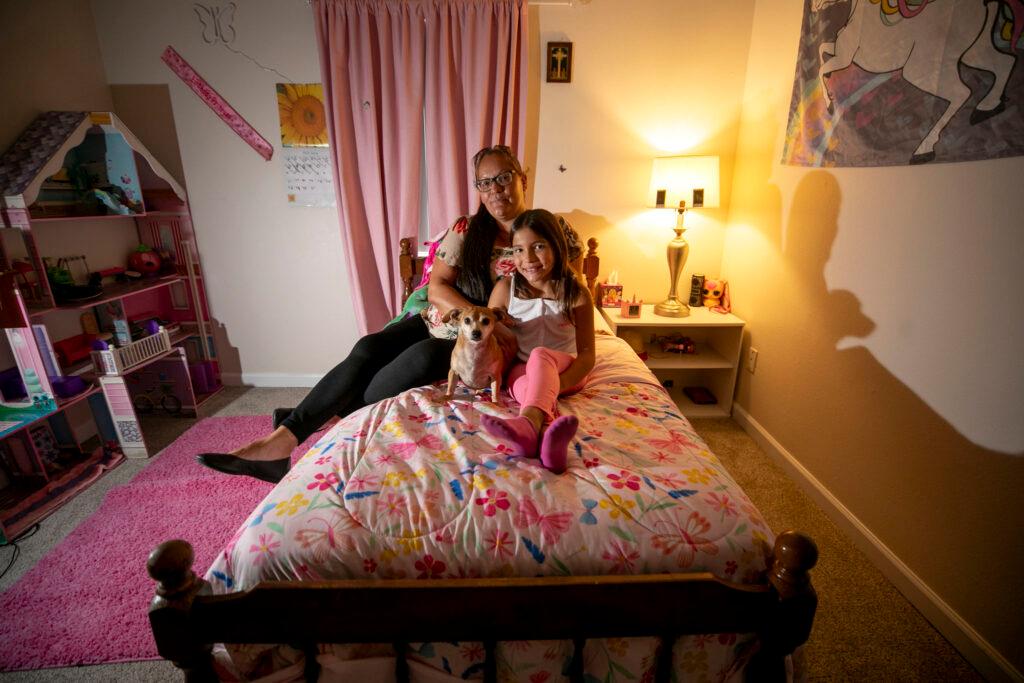
She’d come across Colorado Village Collaborative, which had a safe outdoor space set up on Elati Street in Denver. She spent six or seven months in a tent there, on a raised foundation that had an AC inside.
One day, the staff announced the research study and asked who wanted in: “They did a lottery thing and they got everybody who wanted to put their names in for it. You just go to the case manager; they put your information in; and then I don’t know how they pick people. … I didn’t know that they were doing all that, but well, if they’re going to give me money, I’m going to tell you I needed it.”
She was in the group that received an initial payment of $6,500, then $500 a month during the first year. In the second year, she got $1,000 every month without the balloon payment at the start. “I was excited. I was happy,” she said.
She got into the study and moved into her apartment at about the same time, in November 2022. With the help of the Collaborative, she’d gotten approved for Section 8 housing, so she didn’t need to spend any of that money on a down payment or rent for the 1,000-square-foot, two-bedroom unit in a hardscrabble Southeast Denver apartment complex on the fourth floor. “It was a coincidence. It was just like God planned; God put it all together. It was great,” she said.
Like Ambrose, she said the relief from the stress of day-to-day things had a big impact on her. “They helped me to be stable and to pay my bills and to get on my feet and to be able to buy what I needed, and I wasn’t stressed out. I wasn’t worried ... it gave me a good foundation to build on,” she said.
Palafox arranged a visit to her home on a recent summer afternoon when she wasn’t working a temp job. She stopped watching a TV show about electric vehicles to tour a reporter around, pointing out her niece Lily Little Thunder’s pink bedroom, as well as her own large bedroom, two bathrooms, a kitchen and a living room, where she had her Bible open near a large-screen TV. She spent money from the study to furnish the apartment with a living room set and everything else from a discount chain, she said. Little Thunder moved in with her aunt so she could have more space than at Palafox’s brother’s place – with her, she could have her own bedroom and a little dog.
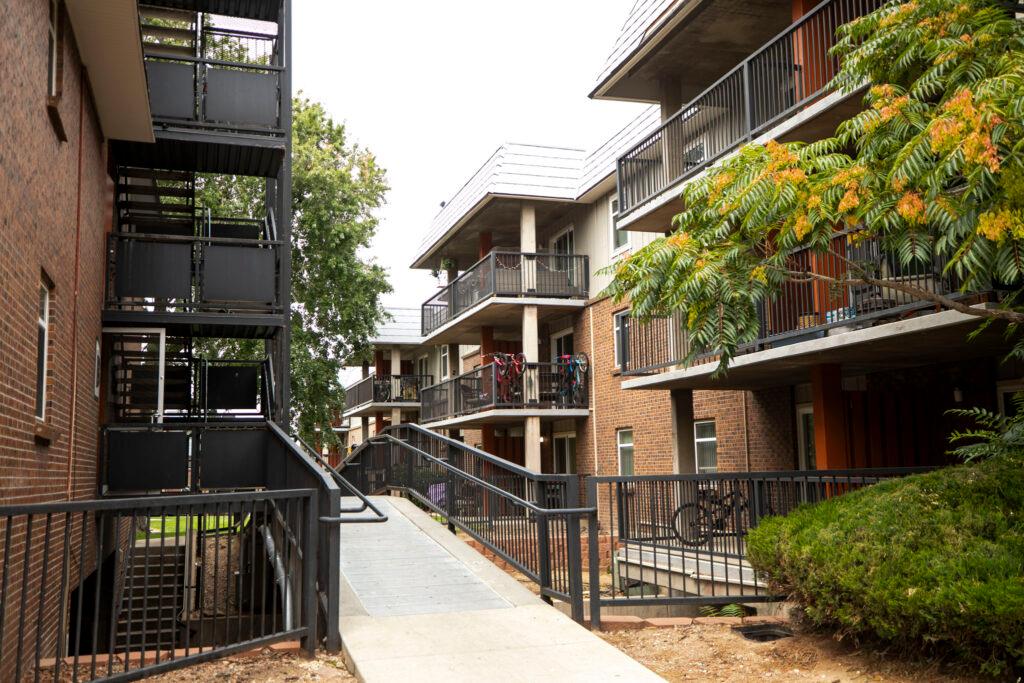
Section 8 covers the rent, but not the bills, which is where the monthly payments have come in handy. When the money hits her debit card at mid-month, she says, “I’d just hold onto it to just pay the bills, pay whatever comes up, whatever I need for my apartment.” Utilities run her about $500 a month.
Employment hasn’t yet become steady. Because she cares for Little Thunder, 9, it’s a challenge to find a job that she can fit in while also taking care of her, but she has that figured out, too. “I got a bunch of temp jobs and I’ll call everybody and find out who has work and I’ll go to work for them.”
She shops for food with food stamps at Sam’s Club and doesn’t socialize much, instead, she keeps an eye on her niece, who likes soccer, gymnastics and basketball. Other nieces and nephews have visited regularly. Lily demonstrated a few cartwheels, back-bends and walk-overs. “She does that all day,” Palafox said with a smile.
When told that the group she was in – recipients of the biggest amount – were doing about as well as the people who were in the control group and mid-range group, she initially said, “That’s crazy! I can’t believe it!”
Her thinking was that those in her group would be faring the best and that those in the control group wouldn’t see much of an impact on their lives – how far would they stretch $50 a month?
Then she thought it over for a minute and realized that, based on what she’d learned about homeless people, the research findings made nothing but sense: The basic income project gave her and others a chance for a solution to their experience of homeless that, had they not been given it, they would have fought to figure out some other way.
“Yeah, I would’ve still worked at it. I wouldn’t have given up on my life.” She said that people seeking services from shelters or other community-based organizations have the motivation to improve their circumstances, unlike members of the unhoused population who – based on her own observations – often don’t.
Mark Gaskin
Mark Gaskin became a part of the middle group of the study nearly two years ago, getting $1,000 a month, an amount that could end in October. It could last longer, depending on whether the study leaders are able to get the funds needed to extend it. He’d been living in his car when he heard about the program. Now, he’s living in a trailer/tent combination hitched to the car, which is usually parked on a quiet street adjacent to Rocky Mountain Lake Park.
The 61-year-old Gaskin said he was feeling anxious about the funding ending, and he wasn’t sure what his next step would be. “That’s a concern of mine because the reality is, I don’t know. I don’t know where I’m going to be able to pay whatever I have to pay for,” he said.
He said he grew up in a big family. After he spent nearly three decades incarcerated, some time locked up in Arizona, he moved in with a nephew in Colorado in 2018. When the nephew got married, Gaskin felt like a third wheel and moved out. He found a job earning $24 an hour as a Traffic Control Supervisor and was living in a cozy two-bedroom house in Commerce City, paying about $1,000 a month.
Things were going well for the tall, slender Gaskin – until he was in a work-related car accident. His job fought him on the workmen’s compensation claim and he lost his job. The $20,000 payout he later got didn’t help in the short term: he fell behind on his rent and was evicted. His criminal background proved an obstacle to staying with family members and has upended his efforts to find a new job.
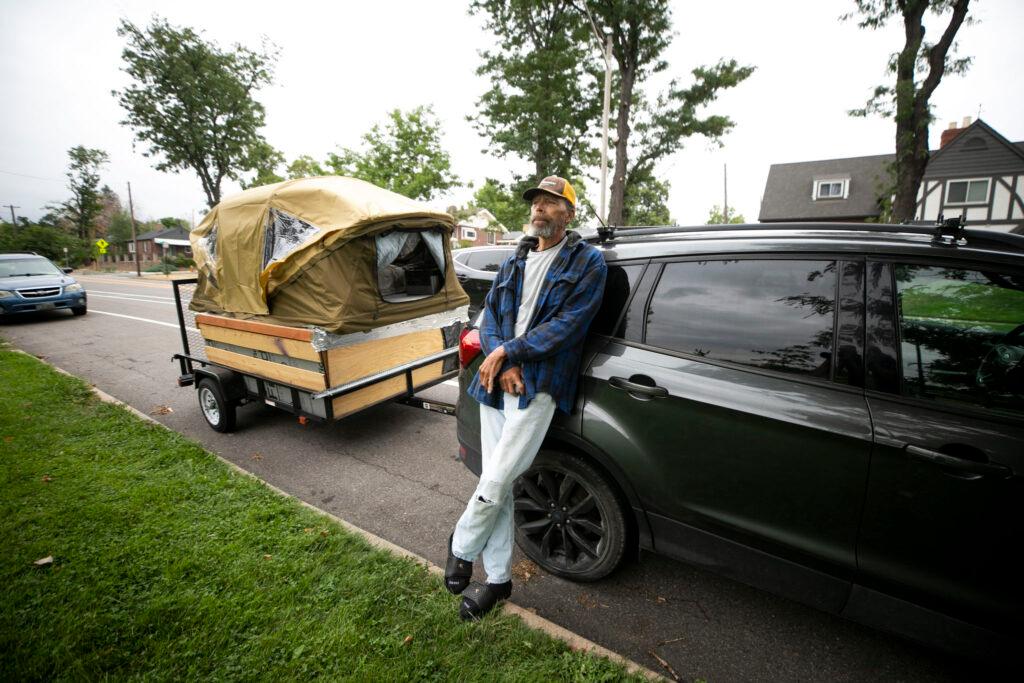
He was taken out of a bus driving training program when his background check hit a snag. And he’s been left with injuries from the accident that keep him from being comfortable standing up or sitting down for too long, he said.
On top of that, he has an obligation to his aunt. He’s the caretaker of his mother’s 81-year-old sister, who lives in an apartment around the corner from the park. “And so with the bad background and the litigation, it's been next to impossible for a company to hire me,” he said. “And that keeps me where I'm at now. . . . it’s hard for me to get a job that’s going to allow me to take care of her and make sure she makes it to her appointments.”
Like Ambrose, he said the emotional support kept him from the brink of losing all hope, and his outlook improved when he got into the research program.
“My stress of not being able to make my car payment was gone,” he said. He also connected with new friends through the program. “The finances was a great start, but for me it has blossomed into being able to talk to people again, to trust people again … ”
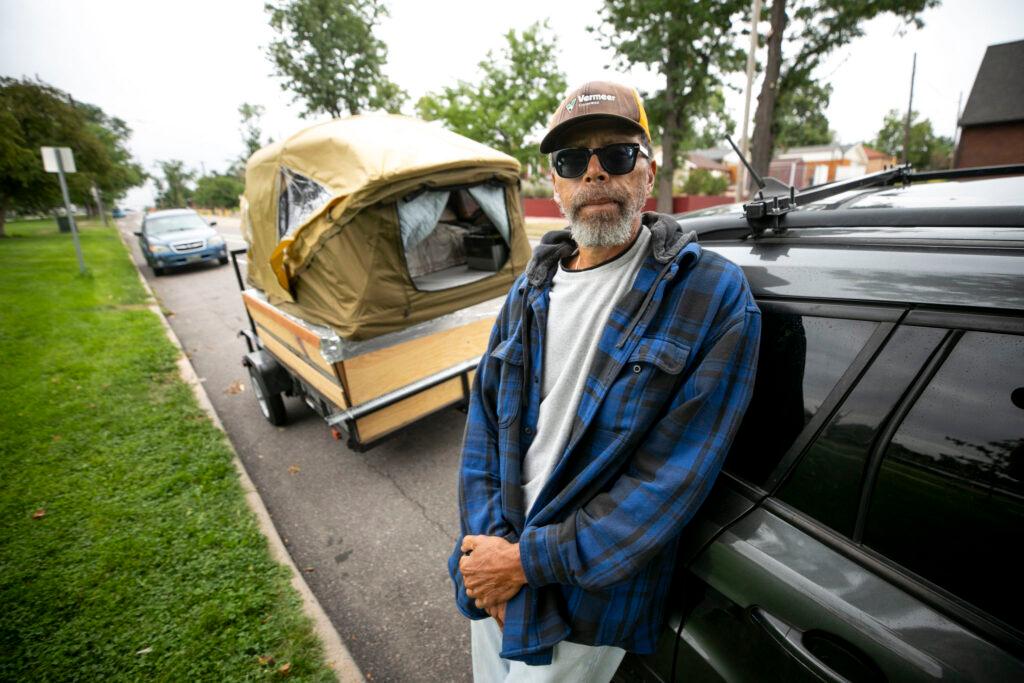
During a recent visit to a grassy knoll where he often sets up a folding chair at the edge of the park within a stone’s throw from his car, he showed how he had managed to upgrade his life with the help of the $1,000 a month the study gives him.
He used a portion of his first payment to buy a rugged beige tent that he equipped with an air mattress and solar panels. Online, he found someone with a trailer to give away – he used $100 in study funds for registration. It has cabinet space where he stores canned goods, a small stove, a camping toilet and equipment to make a fire. The tent goes on top.
Pointing to a storage cubby in the trailer, he said: “I keep a lot of that stuff up there as well as I do use underneath here for my storage ... I do have extra blankets and stuff like that. I know it gets cold in Colorado, so I want to be prepared.”
He’s been learning ways to stretch out the $57 a month he gets in food stamps. “I’ve learned to survive on less – as far as less food,” he said. “I’ll buy ground beef and I’ll make myself some burritos that I can actually eat for a couple days. I buy ramen noodles, things that I know that will sustain me, and [I’m] learning not to be as big of an eater as I used to be.”
He said when the last check comes, he just has to keep on going and will try to figure it out. “Survive the best way I know how,” he said.
Like Palofax and Ambrose, he said that the money was a balm to the stress of homelessness, not the answer that could solve all of his problems. When asked whether he thought those in the $50 a month control group were as likely as he was to find housing – a question that the Denver Basic Income Project also probed – he said it depends on what the individual does with the money they receive, not how much.
“It’s based on the mindset,” he said. “It’s not how little I’m getting, but what I do with what I have.”
Hunter Ambrose would agree – it’s all about motivation. “I believe it is the individuals,” she said. “All those things that I was doing? Those were things that I wanted, before Denver Basic Income Project. Like, how I wanted a better life for myself ... so who I was was already there.”









